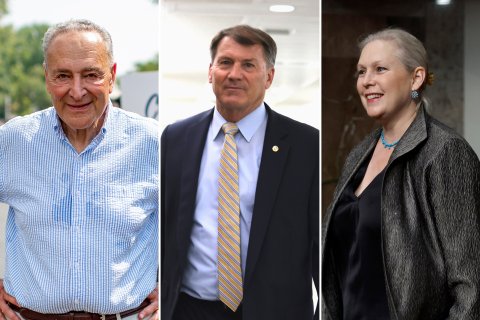Soaring inflation didn't stop U.S. Senators Mike Rounds, Kirsten Gillibrand and Chuck Schumer from shelling out taxpayer money on private air travel last fiscal year.
The trio accounted for most of the $1 million that lawmakers spent on charter flights from October 2021 through September 2022, according to a Newsweek analysis of newly released congressional spending records.
Fewer than a dozen senators fueled the spending. The vast majority of Congress's upper chamber did not fly charter with public funds; expenses were also significantly lower in the House.
Rounds, a Republican, racked up $380,000 in airfare, primarily by commuting multiple times a month to Washington, D.C., from his home state of South Dakota.
Gillibrand and Schumer, both from New York, paid $390,000 combined flying across the state to hold press conferences, meet with constituents and make other public appearances. On several occasions, the Democrats traveled between areas served by nonstop commercial flights, or that were within driving distance of one another.
Rounds, Gillibrand and Schumer - now the Senate majority leader - have outspent their colleagues in each of the past three fiscal years, records show.
Other top spenders include Minority Leader Mitch McConnell of Kentucky, who made more than a dozen trips in fiscal year 2022 alone. Fellow Republicans John Thune of South Dakota and John Barrasso of Wyoming expensed a similar number of excursions. Independent Senator Kyrsten Sinema of Arizona spent more than $55,000 on just five flights.

Staff for most senators did not respond to requests for comment on the spending. Rounds' office said the flights were necessary for him to reach the Capitol from his rural hometown in a timely manner. Spokespeople for Barrasso and Sinema said charter flights allowed the senators to quickly travel across their large states to meet with constituents.
Taxpayers Protection Alliance President David Williams said the Senate should re-examine its travel rules and transparency efforts surrounding the high-priced expenditures.
"It is a wonderful perk to have someone else pay for your travel," he said. "The problem is Congress is spending our money, taxpayer money."
In examining spending records since fiscal year 2020, when the Senate Rules Committee relaxed restrictions on chartering private aircraft, Newsweek found hundreds of flights that together total more than $3 million.
House members members spent under $50,000, booking only about a dozen trips during the same three-year period.
Taxpayers finance the flights via annual allowances given to lawmakers to pay for transportation, staff salaries and office equipment.
Individual senators received between $3.7 million and $5.9 million for the past fiscal year, which ran from October 2021 through September 2022.
Each chamber of Congress has its own travel regulations that strictly forbid personal and campaign trips. However, senators are given more leeway to charter planes for official business.
In the House, representatives can't take private flights to or from Washington, D.C. without prior written permission from the House Administration Committee. The same restriction applies to any trip priced at more than $7,500.
In the Senate, lawmakers don't need pre-approval, but they must show they're traveling to or from an area not served by commercial airlines, or that their schedule necessitated a private flight. Rules Committee staff make the call on what qualifies for reimbursement.
Transparency at the two legislative bodies is also markedly different.
The Senate publishes spending information twice a year, inside reports spanning hundreds of pages. Meanwhile, the House distributes its expenditure data in a spreadsheet every three months.
"It's clear the House has some sort of checks and balances when it comes to charter flights," Williams said. "And those checks and balances seem to have limited the abuse of spending money on these charter flights."
An Expensive Commute
Rounds alone spent nearly $950,000 in three years, most of it traveling between his home state and Washington, D.C.
The junior South Dakota senator regularly flew charter from the rural city of Pierre to the nearby Minneapolis-St. Paul metro area, where he boarded a commercial plane to complete his journey. He made the round trip almost weekly this May, often leaving on Monday and returning on Thursday, with a price tag of $5,200 per charter flight.
Rounds could have flown to work commercially for thousands less if he had instead traveled through Denver, flight information shows. The U.S. allocates millions of dollars a year to subsidize round-trip flights between Pierre and the Colorado capital on a daily basis. It's part of the federal Essential Air Service program, which brings airlines to communities that are not profitable to serve.
But the 68-year-old needed little justification to fly private. Since March 2020, the Rules Committee has allowed senators to forego commercial airlines altogether when commuting from their homes to the Capitol. The rule waiver, intended to keep Congress operating safely during the COVID-19 pandemic, will finally expire in January.
Rounds' office said charter flights are necessary for the lawmaker to consistently make the Senate's vote schedule.
At the start of his first term, Rounds would drive to Sioux Falls so he could fly commercial the entire way, spokesman Dezmond Ward said. But the trip, which regularly totaled 12 hours, was "neither sustainable nor reliable."
The commercial flights from Pierre to Denver, which depart daily at 8:20 a.m., also wouldn't allow Rounds to keep his schedule, Ward said.
The senator has spent more than $200,000 on charter flights every year since 2016, records show. In May 2019, his wife began receiving treatment for an aggressive cancer; Jean Rounds died in November 2021.
Mike Rounds returned more than $700,000 of his $3.8 million annual allowance to Congress this past fiscal year, Ward said.
Despite his use of private flights, Rounds was absent for 20 Senate roll call votes this year as of early November. Most of his colleagues missed fewer than half that, according to GovTrack, a website that monitors congressional activity.
Thune, the state's senior senator, participated in all votes during the same time frame. He spent about $60,000 on charter flights during the past fiscal year.
Most of the votes Rounds missed this year were during a three-day span this February. Ward said the senator was attending his sister-in-law's funeral and visitation services at the time.
Short Flights, Big Bills
Gillibrand's practice of making multi-city flights across New York with her staff has cost more than $800,000 in recent years.
During the past fiscal year, the 56-year-old routinely visited three locations in a single day to hold press conferences about legislation, funding and other initiatives she supported.
Days before Thanksgiving 2021, Gillibrand spent more than $14,000 for herself and three staffers to travel from Washington, D.C., for what she billed as a "day of service" on social media.
The trip's first leg took the senator to Syracuse, where she packed meal kits alongside local dignitaries. Commercial airlines regularly charge less than $200 per ticket for the direct route.
From there, Gillibrand flew to Rochester to visit a refugee outreach center, then to Buffalo where she helped students build outdoor library boxes. The senator's team could have driven to both stops within 90 minutes each.
The charter plane's final destination was the Capitol, another route serviced by nonstop commercial flights.
Williams said trips built around public appearances deserve additional scrutiny.
"This is something that's planned weeks or possibly months in advance, so [there's] even less excuse and less reason to spend this amount of money on charter flights," he said. "Everyone in their personal life, if they had to pay for it themselves, would plan accordingly and try to save money."
Schumer, 72, sometimes chartered planes out of Teterboro, New Jersey.
This May, the Senate majority leader and one of his regional directors paid $2,200 to travel one-way to Albany, where he spoke at a college commencement ceremony. Airlines regularly offer nonstop flights to the city from LaGuardia for a fare under $200.
Altogether, he spent almost $400,000 on charter flights in three years.
Neither senators' staff responded to emails seeking comment on the spending. Schumer has missed 14 votes this year, while Gillibrand has missed five, according to GovTrack.
Environmental Impact
The New York senators have also kept up their charter usage while publicly pledging to fight climate change.
Private plane travel is among the worst modes of transportation for the environment, said professor Greg Keoleian, director of the Center for Sustainable Systems at the University of Michigan.
Charter flights generally burn several times more fuel "per passenger mile" than a car or even large commercial aircraft, which fill hundreds of seats, he said.
Most fuel is burned at take off and landing, making short jaunts even more inefficient.
That hasn't stopped Gillibrand and Schumer, who paid for nine flights this April, the same month they publicly applauded new federal funding awarded for greenhouse gas emissions research at Stony Brook University in Long Island.
Keoleian said senators do have a greater obligation to travel than most people, and that they should be judged for the sum of their actions.
Still, he added, it's important for even elected officials to attend events virtually when possible.
"We're in a climate crisis," he said. "We all need to reduce our emissions. And in terms of charter flights, they are probably the most intensive means of travel."
Update: 12/9 This story originally said Senator Kyrsten Sinema was a Democrat; she changed her party affiliation to independent the day this story was published.











